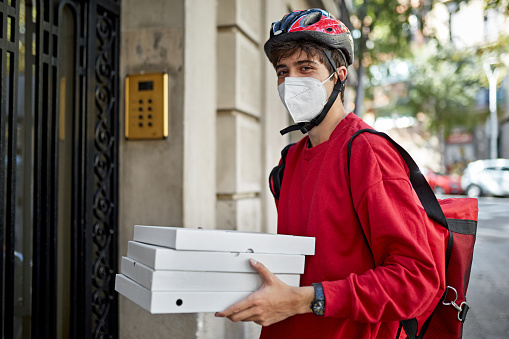Are you looking to become a pizza delivery driver, but need to know how much they make? Consider the potential income before you take on this job. Well, look no fuLookwill discuss everything that goes into determining how much money a pizza delivery driver makes.
From studying factors like wages, ti, ps, and other bonuses, you will gain insight into what kind of salary you can expect as a pizza delivery driver.
Pizza delivery drivers and their job duties

Pizza delivery drivers are responsible for transporting food orders to customers. They may also take payment, verify customer information, and provide customer service.
Drivers are usually expected to know their area well, as they must often navigate through traffic and find addresses quickly. Delivery drivers must also ensure the order is accurate and follow safety precautions, such as wearing a seat belt.
How much do pizza delivery drivers make?

According to ZipRecruiter, the average hourly pay for a pizza delivery driver is $13.46 per hour, with tips ranging from $4-$20 per order depending on location, delivery distance, order size, and other factors. A typical full-time job pays around $26,920 per year. Tips can add up to boost a driver’s wage if they can make more deliveries in a shift.
It is important to note that wages for pizza delivery drivers vary from state to state and even city to city. For example, the average wage for a pizza delivery driver in New York City is reported to be significantly higher than the national average at $16.94 an hour by ZipRecruiter.
This could be due to the higher cost of living in these areas and the competition among restaurants for employees with experience driving in busy cities.
Bonuses are also subject to change depending on location and company policies, but common bonuses may include mileage reimbursement or food discounts.
Factors that determine how much pizza delivery drivers make
The amount of money a pizza delivery driver makes depends on several factors. Job experience and the ability to navigate through busy city streets are important skills that can make you more attractive to employers and help you earn higher wages.
Tips play a major role in how much a pizza delivery driver makes; the better the service, the more likely customers will tip generously. Finally, location is important, as wages vary from state to state or city to city depending on the cost of living, competition for drivers, and company policies.
There is no one-size fits all answer when it comes to how much pizza delivery drivers make. While wages may not be considered high by some standards, they can increase with experience, and tips can be generous if the driver provides great customer service.
While studying these factors will help you gain more insight into your potential income, it is always best to research job postings in your area to get a better idea of what kind of wages are being offered for pizza delivery jobs.
Benefits of working as a pizza delivery driver
- Flexible hours: The job offers many pizza delivery drivers a great opportunity to work flexible hours and make their schedules. This especially benefits those with other commitments, such as school or family responsibilities.
- Variety of tasks: Pizza delivery drivers do much more than just deliver pizzas; they must also take orders, verify customer information, handle payments, and provide customer service. As a result, the job keeps you on your toes and offers variety in day-to-day tasks.
- Interaction with customers: One of the best parts about working as a pizza delivery driver is the human interaction that comes with it. Drivers get to meet new people each shift, which can be fun and rewarding.
- Tips: Pizza delivery drivers often make tips on top of their regular wages, which can add up significantly over time.
- Low start-up costs: Most pizza delivery jobs require no prior experience or expensive equipment; you usually need a valid driver’s license and a reliable car that can accommodate the type of orders you are taking.
- Room for advancement: With the right attitude and effort, many pizza delivery drivers have succeeded in pursuing higher positions within the company or starting their businesses related to food delivery services.
- Fun environment: Working as a pizza delivery driver can be enjoyable if you take pride in your job. You get to explore your city while meeting new people and trying different types of food, all while getting paid.
Working as a pizza delivery driver can be an interesting and rewarding job for those looking for flexible hours and the opportunity to interact with customers. The right attitude and dedication can also be a stepping stone in advancing your career or starting your own business.
Different ways for pizza delivery drivers to increase their earnings
- Utilize a fuel tracker app to minimize trips and save on gas money.
- Look for additional promotions and incentives your company offers, such as referral bonuses or delivery challenges that may increase your earnings.
- Consider signing up for an online food delivery service, like DoorDash or Uber Eats, which can provide additional income opportunities beyond regular orders from brick-and-mortar restaurants.
- Take advantage of peak hours when demand is highest - this will help you make more deliveries in a shorter period and increase your earnings per hour.
- Develop relationships with customers so they feel comfortable tipping you extra each time you deliver their order.
- Utilize a GPS app to help you find the most efficient routes and reduce delivery times.
- Participating in food-related events or catering requests can be another great way to increase your earnings.
- Offer additional services such as setting up tables or providing utensils for an extra fee - this could significantly boost your income if done right.
- Consider delivering items other than pizza, giving you more options for making money on each trip.
- Take advantage of any promotions offered by the restaurant or service you are working with to further maximize your earnings.
These tactics can help pizza delivery drivers make more money and provide customers with better overall service.
FAQS
Is pizza delivery a good business?
Pizza delivery can be a great business if you have the right resources and are willing to put in the effort to make it successful. It's important to consider factors such as cost, customer service, marketing strategies, and product quality when starting any business.
What is the profit margin of pizza?
The profit margin in pizza delivery depends on various factors, such as the type of restaurant, prices charged for goods and services, cost of ingredients, and labor costs. Generally, most restaurants aim to achieve a 30-35% profit margin on each pizza sold.
How is pizza calculated?
Pizza is calculated based on the number of ingredients used, the size of the pizza, and whether it is for delivery or pick-up. The prices can also vary depending on what type of toppings are requested. Some pizzerias may offer discounts for larger orders or if customers order several pizzas at once.
Conclusion
As you can see, depending on the number of hours worked, the business they work for, and other circumstances, the amount of money a pizza delivery driver makes in a week or month can vary dramatically. The average driver makes little above minimum wage, with the possibility of additional tips. Some people choose to work for a larger, more established national franchise with set pay rates, while others may discover that dealing with neighbourhood pizzerias directly gives them more control over their pay.

2024 Showdown: OneUp Trader vs TopStepTrader for Funded Trading Accounts

Exploring Landa: How This Real Estate Investment App Works and Its Benefits

Wagmo Pet Insurance Uncovered: Features, Pros, and Cons Explored

The Impact of Direct Taxes on Economic Development

A Look at North American Savings Institutions in 2023

What Is the Series 7 License?

Progressive Business Insurance

Currency Valuation 101: What Really Affects Exchange Rates

7 Mistakes To Avoid When Getting A Used Car

An In-Depth Review of Goat Funded Trader in 2024

A Quick Guide to GAAP for Small Businesses
